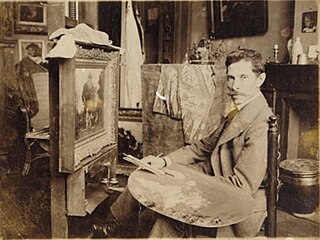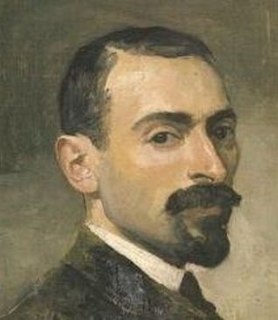
The Rijksakademie van beeldende kunsten was founded in 1870 in Amsterdam. It is a classical academy, a place where philosophers, academics and artists meet to test and exchange ideas and knowledge. The school supports visual artists with a two-year curriculum.

Pieter Florentius Nicolaas Jacobus Arntzenius was a Dutch painter, water-colourist, illustrator and printmaker. He is considered a representative of the younger generation of the Hague School.

Hildebrand Lucien (Hildo) Krop was a prolific Dutch sculptor and furniture designer, widely known as the city sculptor of Amsterdam, where his work is well represented.

Sjoerd Hendrik de Roos, better known as S.H. de Roos, was a Dutch type designer, book cover designer and artist.

Pulchri Studio is a Dutch art society, art institution and art studio based in The Hague ('s-Gravenhage), Netherlands.

Johannes Evert Hendrik Akkeringa was part of the second generation of the Hague School painters. Akkeringa is primarily known for his paintings and watercolours of women and playing children at the beach, women mending nets and intimate tea-time conversations.

The Amsterdamse Joffers were a group of women artists in Amsterdam who met weekly in the last quarter of the 19th century to paint and show their works together. They were known for their style that followed the example of the Amsterdam Impressionists, and were all members of the Amsterdam artist societies Arti et Amicitiae and Sint Lucas, and most followed the lessons by professor August Allebé of the Rijksakademie van beeldende kunsten of Amsterdam.

August Allebé (1838–1927) was a 19th-century artist and teacher from the Northern Netherlands. His early paintings were in a romantic style, but in his later work he was an exponent of realism and impressionism. He was a major initiator and promoter of Amsterdam Impressionism, the artist's association St. Lucas, and the movement of the Amsterdamse Joffers. Amsterdam Impressionism – sometimes referred to by art historians as the School of Allebé – was the counterflow to the very strong Hague School in the movement of Dutch Impressionism. As a professor at the Royal Academy of Amsterdam he fostered a cosmopolitan attitude toward art and the promotion and motivation of his students, and provided a significant stimulus to developments in modern art.
Jan Hoynck van Papendrecht was a Dutch painter and illustrator, famed for his military art.

Jacob Simon Hendrik Kever, known as Hein was a Dutch genre and still-life painter; associated with the Laren School.

Jan Hillebrand Wijsmuller was a Dutch painter. He belongs to The 2. Golden Age of Dutch Painting.

Theodoor Christiaan Adriaan (Theo) Colenbrander Dutch architect, ceramist plaque painter, and designer, characterized as the first Dutch industrial designer.

Alexander Theodore Honoré Struys was a Belgian genre and portrait painter in the Realistic style.

Franz Wilhelm Maria Deutmann was a Dutch painter and photographer. He was a member of Arti et Amicitiae and is considered to be part of the Laren School, an offshoot of the Hague School, which is an independent part of the international movement of impressionism.

Maurits Joseph Niekerk was a Dutch Impressionist painter of Jewish ancestry who spent much of his career in Belgium.

Johan Henri Gustaaf Cohen, known as Johan Cohen Gosschalk was a Dutch jurist, graphic artist and painter of Jewish ancestry. His sister, Meta Cohen Gosschalk, also became a well known painter.

Richard Nicolaüs Roland Holst was a Dutch painter, draftsman, lithographer, book cover designer, etcher and writer. Many of his works were in a modified Symbolist style.

Kees van Waning was a Dutch painter. His work was part of the painting event in the art competition at the 1928 Summer Olympics.

Maria Ida Adriana Hoogendijk (1874-1942) was a Dutch painter.

Maria Adeline Alice Schweistal or Fanny Psicha (1864-1950) was a Belgium born Dutch artist. She was known for her still lifes.




















